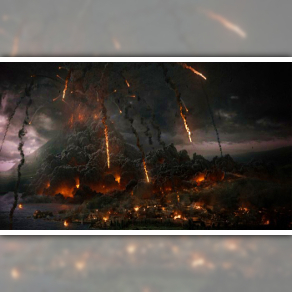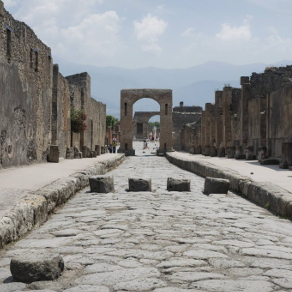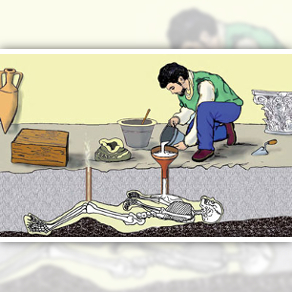The Tragedy
Over the course of time, even if Pompeii had to deal with many hard political and military events, it carried on regularly its development from a small agricultural village to an extended and influent commercial and manufacturing city.
The first difficult tragedy was the violent earthquake happened on 5 February 62 A.D. (It had an estimated magnitude of between 5 and 6 on the Mercalli intensity scale with epicentre in Stabiae) that provoked severe damage to much of the city, among which Porta Vesuvio, Castellum Aquae, Forum and the Temple of Jupiter.
The renovations had not been completed yet when on the morning of 24 August 79 A.D. (naturalists believe it happened on 24 November because of the discovery of autumn fruit traces) the second and irreparable tragedy occurred: Mount Vesuvius, for ages an inactivate volcano and, for this reason, a place full of fertile vineyards and sumptuous villas, woke up with an extreme volcanic eruption strength.
Pliny the Younger (roman writer and senator) who was staying at Misenum, was witness of the frightful show "I cannot give you a more exact description of its appearance than by comparing to a pine tree": in this way he described it in a letter to Tacitus (roman historian, orator and senator), announcing the tragic uncle death too, Pliny the Elder, the commander of the Misenum fleet who, moved by his scientific passion, launched a fleet to look closer and died helping and supporting his friend Pomponiano.
Rapidly an enormous cloud of smoke formed on the top of the flames and blotted out the sun. This was compounded by a constant rain of incandescent lapillus and stags, a wave of ash and poisonous gas, a long series of earthquake and tsunami.
This phenomenon lasted three days and at the end Pompeii and the cities of Stabiae, Herculaneum and Oplontis were buried under approximately 6 meters of volcanic material.
It is not known the exact size of the population in 79; according to some estimates, it varies from 6.000 to 20.000 and the number of the victims found is around 1.150: it is calculated that the victims can be approximately 1.600, considering the part of the city that has to be explored and also that the majority of people could get away safely when the eruption started.
About the 1.150 verified victims, 394 were found in the lower layers of lapillus, died inside the buildings that collapsed under the weight of the volcanic materials amassed on the roofs, whereas other 650 were found on the higher part of the deposit, died outside, hit by the burning clouds during the second stage of the eruption.
Many Pompeiians tried to escape from ashes and lapillus covering their mouth with a pillow; those who sought refuge running away toward Herculaneum met their death, while safety was more probable for those who run away toward Stabiae, by sea, even if the seaside was hit by swells for the incessant earthquakes and the boats were almost all destroyed.
Following archeological dig and the application of the place mold technique it was possible rebuilt the final moments of some inhabitants, such as a woman who brought so many jewels, who went with an adolescent with the head enveloped by a sheet, a begging with a walking stick and a sack full of food, a married couple holding hands, a man, maybe an athlete who carried an oil bottle to grease himself, a group of thirteen people, among which a slave, two children and an ill woman, some ministers of the Temple of Isis, one of them found with many precious objects, probably the treasure of the temple and a group of slaves found in a room of 4 square meters with broken bones, after trying to run away from the roof using a ladder. Even the animals died: among the most surprising examples, the desperation felt by a dog that tried to release from its leash.
When the eruption ended, the Vesuvius had a new form that is two tops and a new cone: Pompeii and the surrounding area were covered by a white blanket, the river Sarno had difficulty flowing and coastline was changed, extending toward the sea.
Emperor Titus sent a rescuer delegation and forbade the transit in the areas hit by the eruption. Moreover ordered that all the proprieties without heirs would be dismantled and the materials (marble, lead water pipes, statues and so on) recovered for the rebuilding. Profiteering was frequent.
In 120 A.D., Emperor Hadrian restored practicability toward Stabiae and Nocera, but the city wasn’t rebuilt, rather the territory where it rose started to be covered by wild vegetation, disappearing completely.






